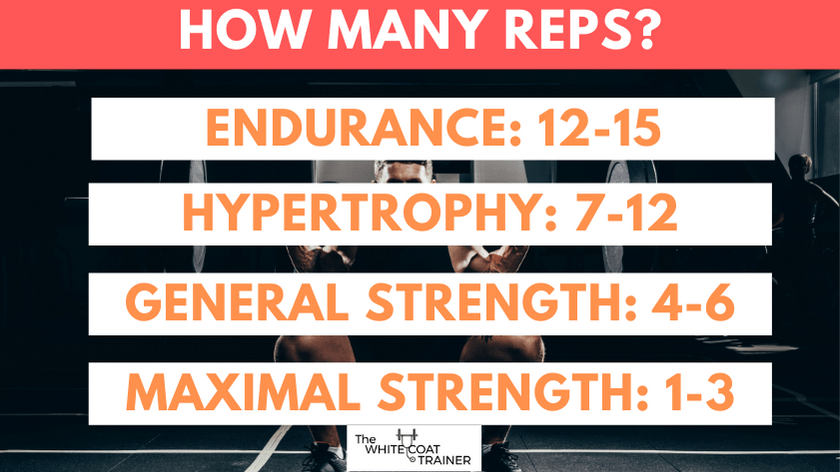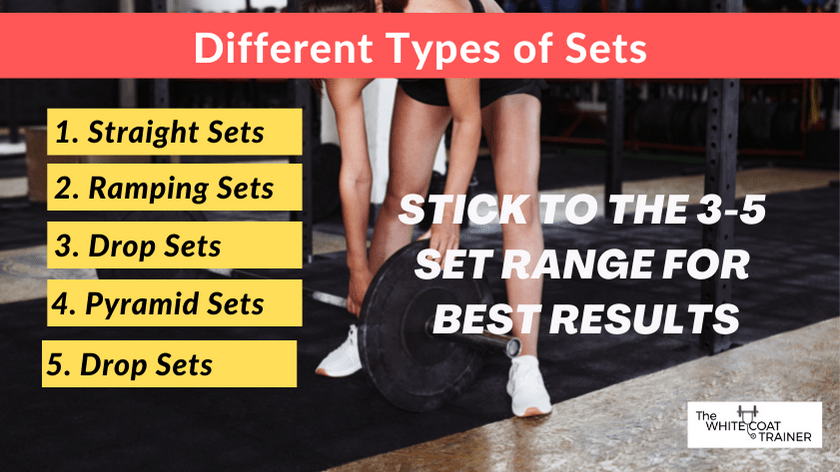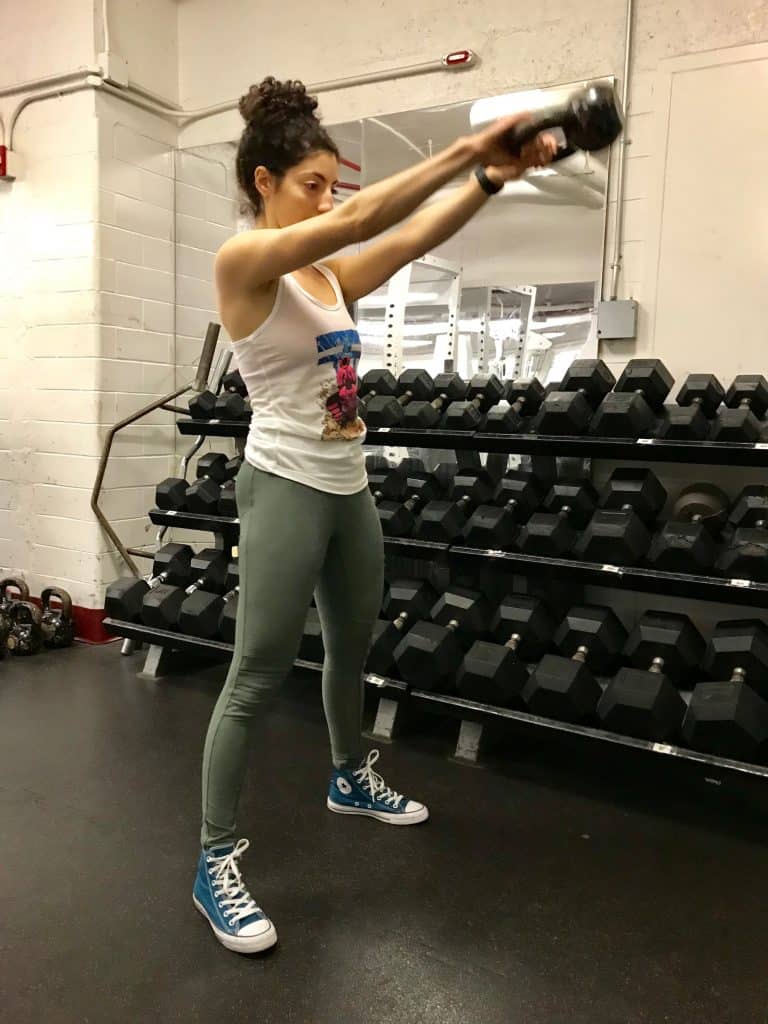Today you’re going to learn exactly how many sets and reps you should do every time you workout.
This weight lifting sets and reps guide will help you build more muscle, gain more strength, and improve the efficiency of your workouts.
Let’s get started.

Part 1: Reps
How Many Reps Should You Do?
In general, you should perform anywhere from 4-12 repetitions per set for the vast majority of your workouts.
The precise rep scheme will depend on what your specific goal is, which can include muscle growth, strength, or endurance.
Can you do fewer than 4 reps or more than 12? Sure, but this won’t be the most efficient use of your time.
So, now let’s go over the ideal number of reps you should do for each exercise.
So the first question you must ask yourself is:
What is your goal?
The Four Different Types of Rep Ranges:
In general, there are four different ways you can split up your training:
- Are you working out to build muscle?
- to get stronger?
- to develop maximum strength?
- or to improve your endurance?
Focus on one at a time. Trying to do more than one simultaneously can lead to mediocre results.
Let’s go over them one by one.
1) Muscular Endurance:
Muscular endurance is the ability to make your muscles work for a long period of time without fatigue.
This is ideal for you if you enjoy aerobic exercises of long duration such as CrossFit, rowing, and swimming.
Endurance responds best to high reps.
The best rep range for muscle endurance is 12-15 reps per set
2) Muscular Hypertrophy:
Muscular hypertrophy is the process of growing and developing muscle size.
If you want to develop bigger glute muscles or show some muscle definition in your back, then you need to do hypertrophy training.
Hypertrophy responds best to a moderate rep range.
The best rep range for hypertrophy / muscle growth is 7-12 repetitions per set
3) General Muscular Strength:
General strength refers to the ability to lift higher amounts of weight relative to your own body weight.
I believe that everyone should achieve a minimum baseline level of strength.
General strength training is important because it can:
- Help build strong bones and decreases your risk of osteoporosis
- Make it easier for you to do everyday activities
- Can lead to an improvement in body image, even without physical changes in your appearance
Strength gains require the use of low reps and heavy loads.
The best rep range for muscle strength is 4-6 repetitions per set
4) Maximal Strength:
Maximal strength is the ability to lift the most amount of weight as you possibly can.
If you are a beginner, this is not for you.
You should train for maximal strength once you have been working out for at least 1 year, and you want to participate in strength sports such as powerlifting, Olympic weight lifting, and strong man.
Or, if you’re curious what your one-rep max is, you can dabble in this rep range 2-3 times a year.
The best rep range for maximal strength is the lower rep range: 1-3 repetitions per set

I generally recommend that you stick to the muscular hypertrophy and general strength rep ranges for the majority of your training.
What Exactly Are Reps?
Let’s define what reps are.
Repetitions (or reps for short) refers to the number of times you perform a specific exercise before taking a break.
For example:
If you press a dumbbell over your head 10 times before resting, that is considered 10 repetitions.
Is It Better To Lift Heavy Or Do More Reps?
If you want to build significant amounts of strength, you have to go heavy. If you are only interested in building muscle (hypertrophy), you don’t need to go that heavy.
The rule of thumb is this:
You should lift a weight that is heavy enough that you cannot easily exceed the number of reps in your goal rep range, but not so heavy that you cannot accomplish the minimum number of reps you are aiming for (with good form)!
In addition, you should aim to leave at least 1 rep in the tank on every set.
What does this mean?
It means that you shouldn’t be taking your sets to absolute failure.
Do your best to leave something on the table in each set.
We discuss weight selection in much more detail in: How Much Weight Should You Lift?
How Many Reps Is Too Many? Can You Do Too Many?
Yes, it is possible to do too many reps in a set.
As with all things, too much of a good thing can be detrimental.
I personally don’t go higher than 12-15 reps, but others may find it beneficial to do so.
Anything greater than 20 reps in a set is probably far too many.
Performing this many reps in a set will have diminishing returns.
If you can easily do more than 20 reps, then the weight you are using is probably too light or too easy to elicit any significant growth.
The only exception to this rule is 20 rep squats!
Many people have gained a great deal of strength and muscle using 20 rep squat programs, but this is not for the faint-hearted!
Going above 20 reps can also useful for beginners focusing only on bodyweight exercises.
Otherwise, stick to the rep ranges mentioned above.
Is It Better To Do Reps Or Time?
I recommend you focus on reps rather than time because you can always be objective with the number of repetitions you do.
Time is a double-edged sword. You can either
- slack off and let the timer run down as you do your reps slowly, or
- you rush through the repetitions in an effort to get as many as possible before the timer runs out.
Both approaches can create sub-optimal results.
Okay, so now you know how many reps you should do.
What about sets? How many sets are ideal to build muscle and strength?
Part 2: Sets
How Many Sets Should You Do Per Workout?
In general, you should do anywhere from 3-5 sets per workout, depending on the number of repetitions you are doing.
Sets and reps and inversely proportional.
- The more repetitions you perform on each set, the less sets you need to do.
- The fewer reps you perform on each set, the more sets you should do.
Just in case, let’s go over some definitions.
What Is A Set?
A set refers to the number of times you perform a specific number of consecutive repetitions.
For example:
Let’s say you do 10 push-ups, rest for 2 minutes, and then do 10 more push-ups.
That is 2 sets of 10 repetitions, or 2 x 10.
Are 2 Sets Enough?
2 sets can be enough if you perform at least 10-12 difficult repetitions per set. This is ideal if you are training for hypertrophy and you are approaching failure in each of those two sets.
Keep this in mind.
2 sets are better than nothing. If you only have time for 2 sets, then do 2 sets.
Heck, single sets are better than nothing.
How Many Sets Should I Do Per Week?
I recommend that you perform 6-10 sets per muscle group per week.
You can accomplish this by training each of the major muscle groups two times each week.
Are There Different Ways of Splitting Up Your Sets?
Ok, so now you know how many sets and reps you are going to do.
The last thing that you have to decide is what kind of sets you are going to do.
In general, there are four different types of sets that you can do.
- Straight Sets
- Ramping Sets
- Drop Sets
- Pyramid Sets
- Super Sets
What Are Straight Sets?
A straight set is the standard method of lifting that everyone is familiar with. You perform all sets of a specific exercise using the same weight.
The repetitions may or may not remain the same across the sets (due to fatigue etc).
Example of straight sets:
- Set 1: 150 lbs squat for 8 reps
- Set 2: 150 lbs squat for 8 reps
- Set 3: 150 lbs squat for 8 reps
In my opinion, straight sets are the only type of sets you need to do.
What Are Ramping Sets?
Ramping sets are when you increase the weight of the exercise on each set, for a specific amount of sets.
In other words, each set uses heavier weights.
The repetitions may or may not remain the same across the sets.
Example of raming sets:
- Set 1: 140 lbs squat for 8 reps
- Set 2: 150 lbs squat for 8 reps
- Set 3: 160 lbs squat for 8 reps
Ramping sets have the advantage that they help you build up momentum for one top heavy set.
The disadvantage of this style of training is that it will decrease the overall volume that you perform as the first set will be “light.”
You can overcome this by performing drop sets after your top set.

What Are Drop Sets?
Drop sets are when you perform additional sets at lighter weights after doing one or more sets with heavy weight.
Drop sets can help you accumulate more training volume if your working sets are too heavy to do straight sets.
Example of drop a set:
- Set 1: 160 lbs squat for 6 reps
- Set 2: 160 lbs squat for 4 reps
- Set 3: 140 lbs squat for 8 reps
If you are a beginner, I rather that you perform straight sets at a weight you can sustain for at least 3 sets.
What Are Pyramid Sets?
Pyramid sets are when you progressively use heavier loads on each set until you reach a top set, and then work your way back down, decreasing the weight back to where you started.
It’s almost a combination of ramping sets and drop sets.
Example of pyramid sets:
- Set 1: 130 lbs squat for 8 reps
- Set 2: 145 lbs squat for 8 reps
- Set 3: 160 lbs squat for 6 reps
- Set 4: 145 lbs squat for 8 reps
- Set 5: 130 lbs squat for 8 reps
As you can see, pyramid sets allow you to accumulate a lot of training volume, however, they require you to do several additional sets.
This style of training is useful for those wanting to maximize hypertrophy.
My recommendation:
Stick to straight sets for the majority of your training, by using a weight that you can manage for at least 3 total working sets. If you have time you can throw in an additional drop set.
What About Supersets Vs Circuits?
There are two other types of sets I want to tell you about.
Supersets and circuits.
What Is a Superset?
A superset is when you alternate between two different exercises, performing a set of exercise A, followed by one set of exercise B and so on.
- Set 1A: 150 lbs squat for 8 reps
- Set 1B: 10 reps of close grip push-ups
- Set 2A: 150 lbs squat for 8 reps
- Set 2B: 10 reps of close grip push-ups
- Set 3A: 150 lbs squat for 8 reps
- Set 3B: 10 reps of close grip push-ups
Advantages:
The advantage of supersets is that it allows you to perform more work in less time.
When doing straight sets, you will generally rest 2-4 minutes between sets.
With supersets, you will only rest 1-2 minutes between sets, decreasing the total time of your workout, while accomplishing the same amount of volume.
Disadvantages:
The disadvantage of supersets is that you might not be 100% fresh for each exercise since your overall rest times are decreasing.
I recommend that you use supersets only for your secondary/”minor” exercises.
Okay, now let’s put it all together and combine all this information.
Part 3: Putting It All Together
How Many Sets And Reps Should I Do As A Beginner?
As a beginner, I recommend that you do 15-30 total reps per exercise. This is the perfect sweet spot for strength and hypertrophy.
So how many sets and reps you should do per exercise depends on the rep range selection you chose from above.
- If you are doing 8 reps per set, then you only need to do 3 total sets
- If you are doing 5 reps per set, you should do ~4 sets
- If you are doing 12 reps per set, you can get away with 2-3 sets.
Using this information, you can construct the following guide:
The WCT Weight Lifting Sets & Reps Chart
| Goal | Reps | Sets |
|---|---|---|
| Endurance | 12-15 | 2-3 |
| Hypertrophy | 7-12 | 3-4 |
| General Strength | 4-6 | 3-5 |
| Maximal Strength | 1-3 | 4-5 |
How Many Sets and Reps Should You Do For Muscular Endurance?
If you are training for endurance / metabolic conditioning, you can and should exceed the 15-30 rep sweet spot. Endurance training will require you to perform a lot of repetitions and in a short amount of time.
Here are the guidelines.
- Perform 12+ reps per set
- Do 2-3 sets per exercise
- Aim for ~ 40 total repetitions of each exercise
To Build Muscle?
So how many sets should you do for hypertrophy? I recommend that you stick to the upper limit of the 15-30 rep per exercise sweet spot.
Here are the guidelines:
- Perform 7-12 reps per set
- Do 3 sets per exercise
- Aim for 25-35 total repetitions of each exercise
For Muscular Strength?
If you are training for general strength, then you need to lift sufficiently heavy weights, where you can only do 4-6 repetitions per set.
Here are the guidelines:
- Perform 4-6 reps per set for strength
- Do 3-4 sets per exercise
- Aim for 12-25 total repetitions of each exercise
For Maximum Strength?
Maximal strength training is super fun, and it allows you to display how strong you really are.
Again, just make sure that you have adequate experience under your belt, and you use proper form!
Here are the guidelines:
- Perform 1-3 reps per set
- Do ~5 sets per exercise
- Aim for 8-15 total repetitions of each exercise
Other Related Questions
How Many Sets And Reps Should I Do To Lose Weight?
If your goal is to lose weight and burn fat, then it is best to perform a high number of sets and reps at a moderate intensity.
Go for 12+ reps per set, and at least 3 sets with short rest periods (like 90 seconds of rest).
Training like this will improve your muscular endurance, and also improve your aerobic capacity.
You might also benefit from circuit training (which I’ll discuss later).
Do Higher Reps Burn More Fat?
The more repetitions you perform, the more calories you will burn.
So yes, higher reps can burn more fat.
With that said, it will also be beneficial for you to train for muscular hypertrophy. The more muscle mass you have, the higher your basal metabolic rate will be.
But don’t forget, exercise alone will likely not lead to any significant amount of weight loss.
You must also make changes to your diet to maximize your fat burning potential.
How Many Reps Should I Do To Tone?
There is no such thing as “toning.” You can either build muscle or burn fat.
In order to improve ” muscle tone “, you need to do both- increase your muscle mass percentage while decreasing body fat.
You can do this using the hypertrophy and metabolic rep ranges of 7-15 repetitions per sets.
How Many Reps and Sets Should A Woman Do?
In general, women don’t need significantly different sets / rep recommendations than men.
The major difference is that women on average can handle more volume than men. This can be in the form of more repetitions per set, or more total sets.

How Often Should I Change The Number of Sets And Reps I Do?
For the best results, you should change the number of sets and reps that you do every 4-6 weeks.
In general, you could change the number of sets and reps that you do per exercise
- every workout (which is known as daily undulating periodization), or
- every four to six weeks (which is known as block periodization).
You won’t be able to continue making progress if you are always doing the same number of repetitions.
You make progress by providing your body with a progressive overload stimulus that changes in difficulty over time.
Only doing high school algebra for 5 years won’t make you a better mathematician. You have to continuously challenge yourself as you become more advanced.
One of the easiest ways for you to do this is to train for different training goals every 4-6 weeks.
For example:
- You can do 1-2 training cycles using 10-12 reps per set
- Followed by 1-2 training cycles using 8-10 reps per set
- Followed by 1 training cycle using 4-6 reps per set
This is an example of block periodization, which is the best method of training in my opinion.
What Is Block Periodization?
Block periodization is when you dedicate a specific amount of time to training for a specific goal.
Using this model, you can train for hypertrophy for 4-6 weeks, followed by general strength for 4-6 weeks, followed by maximal strength for 4-6 weeks.
Any combination is possible.
If you’d like, you can alternate between strength and hypertrophy cycles and never do endurance or maximum strength blocks.
Or you can train for endurance, and then hypertrophy, and then for strength.
Your specific goals will dictate what your training cycles should look like.
My recommendation:
- If you are a beginner, I recommend that you perform 2 hypertrophy blocks, followed by 1 strength block
- Alternatively, you can perform 1 endurance block, followed by 1 hypertrophy block, and then 1 strength block
- If you are an intermediate trainee, I recommend that you perform 1-2 hypertrophy block, followed by 1-2 strength blocks, and a maximal strength block
A StrengthTraining Program That Uses All Of These Principles:
That was a lot of information.
You can now piece together all of this and apply it to your current workout program, or you can create a brand new program using these principles.
But why do all of that work?
I have already created a comprehensive training manual that takes all of the guesswork out of the equation.
Get the WCT Strength Program, plug in your desired compound exercises, and the template tells you exactly what to do.
P.S. There are male and female versions of the template.

How Did You Like My Weight Lifting Sets and Reps Guide?
So to sum it up:
- Identify which weight training goal you would like to improve first: endurance, hypertrophy, general strength, or maximal strength.
- Most people should stick to hypertrophy and general strength, in a 2:1 or 3:1 ratio
- Change your repetition range every 4-6 weeks based on your goals
- If you want to improve your endurance: Do sets of 12-15 reps per set
- If you want to get muscular hypertrophy: Do sets of 7-12 reps per set
- If you want to improve your overall strength: Do sets of 4-6 reps per set
- If you are a strength athlete and want to improve maximal strength: Do sets of 1-3 reps per set
- For each individual exercise, stick to the 3-5 total set range, averaging 15-30 total reps per exercise
The next step is to learn:
- How Much Weight Should You Lift To Build Muscle & Gain Strength?
- How Long Should You Rest Between Sets To Maximize Growth & Efficiency
- The Best Compound Movements To Include In Your Routine
Now I’d like to hear from you.
Which of the four fitness goals are you going to work on first?
Let me know by leaving a comment below.

Alex Robles, MD, CPT / Brittany Robles, MD, MPH, CPT
Alex & Brittany Robles are physicians, NASM Certified Personal Trainers, and founders of The White Coat Trainer: a resource dedicated to improving the health and fitness of busy professionals using time-efficient strategies. Their advice has been featured in My Fitness Pal, Prevention, Livestrong, Reader’s Digest, Bustle, The Active Times, and more. Learn more about them here.

What do you suggest for a 69 y/o. My goals are to have enough strength to enjoy golfing and hiking and staying reasonably active. Also to help maintain balance. Thanks
Hi Robert,
Thanks for your comment. I think the general rules of training for hypertrophy will still be ideal for you. There is probably no need to go below 6 reps. Stick to weights where you can get 7-15 reps per set.
Thank you for this excellent overview of reps and sets. I am a 60 year old male. Would you give different rep/set recommendations for someone my age?
Hi Rook,
Thanks for your comment. The sets/reps recommendation should remain the same at your age, but it will probably be less beneficial for you to train below 6 reps. Stay primarily in the hypertrophy and endurance rep ranges.
How you ever experimented with Reverse Pyramid Training? The first set is the heaviest set and the following sets get progressively lighter. I just recently started training that way and I so far I prefer it over the straight sets I had been doing.
I tried it for a short while, but I kept the follow up sets at the same weight. What differences have you noticed since using this method?
My strength has been going up on the main lifts for the first time in probably a year. It feels like most of the benefit comes from hitting that first heavy set completely fresh and at a high RPE (9+). It also easier mentally to push each set hard because you know the next set will be lighter. When doing straight sets I tend to kind of coast on the first couple sets because I know that if I push my RPE too high I’ll never be able to get my reps on the last couple sets.
That’s a great point. It’s similar to something I’ve tried recently as well, where I only did 2 working sets. The first set I went pretty hard (RPE 9), and the second I gave it whatever I had left. I think that’s the beauty of fitness. So many roads leading to the same path!
This is all great reading. I’m curious to know what you think of the Body Pump-type classes offered at many gyms. (This is extremely high reps and low weights.) I enjoyed these classes a lot, but felt like I wasn’t progressing by taking them.
I think you hit the nail right on the head. Those classes are great for getting in a “workout”- wHich just means you sweat and burn calories with no real goals or objectives. I don’t think they are a great investment as you won’t necessarily get better at anything from those types of classes. You are much better off doing your own individualized training to meet your own personal goals.
It really works and makes your workouts hard and challenging